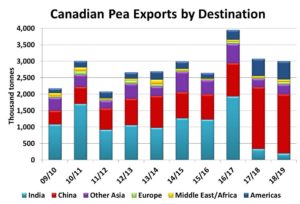Pulse Market Insight #176 SEP 14 2018 | Producers | Pulse Market Insights
Interesting Developments in 2017/18 Pea Exports
There’s been a whole lot of handwringing over the status of Indian pulse imports, and rightfully so; India has been a key part of the market. That said, Canada’s 2017/18 export results show some interesting shifts that will also have implications for the 2018/19 outlook. In some ways, while everyone was focused on India, other export destinations became more important.
That’s especially the case for peas. Readers might be surprised if they realized 2017/18 Canadian pea exports were the second highest on record, but that’s certainly the case. In the year just completed, 3.08 million tonnes of peas were exported and while that’s down from last year’s record, it means 2017/18 has moved into second place. Not bad after all the doom and gloom seen earlier.
The better-than-expected exports showed up late in 2017/18; volumes for the fourth quarter of 2017/18 were 950,000 tonnes, more than double last year’s Q4 total. That strong pace late in 2017/18 also provides some optimism for the start of 2018/19. True, we won’t see the huge Sep/Oct/Nov spike that normally comes from Indian purchases, but the pace will be solid.

Just as important, the strong 2017/18 pea exports did not depend on Indian demand. Last year, India imported 337,000 tonnes, down 83% from last year and the smallest total since 2003/04. This caused India to drop into third place among Canadian pea buyers.
China took over top spot in 2017/18, taking 1.88 million tonnes of Canadian peas, an 84% increase over last year. Chinese pea imports (from Canada and elsewhere) have been generally increasing over the past number of years but this increase was a surprise. It didn’t hurt that China is trying to find alternate livestock feed sources due to its trade dispute with the US.
With China moving into the leading role, it’s also a little ironic that the US moved into second spot of Canadian pea buyers. In 2017/18, the US bought 355,000 tonnes of peas, triple the previous year. Presumably, most of this movement south of the border is destined for milling and fractioning plants in the US, which is seen as a solid ongoing demand. It also provides a bit of a look ahead to the possibilities for Canada as domestic situation, once more fractioning plants come on stream north of the border.
While the 2017/18 export performance was interesting and encouraging, it also provides some clues for 2018/19, the marketing year just started. The export chart above also includes our forecast for 2018/19 exports. The first thing to notice is that we’re really not counting on India again in the upcoming year. Indian import bans remain in place for now and we’d rather build our forecast based on current reality, rather than wishful thinking.
Even without India in the picture, 2018/19 export demand will be firm. China will be a large buyer again, with the outlook for a resolution in the US/China trade dispute still in question. Countries surrounding India will also remain in the market. We’ve penciled in a few more exports to Europe and those could turn into larger volumes as EU feed prices have strengthened due to the drought-reduced crops in the north. Europe is already buying sizable volumes of Black Sea peas. And for the US, we’re expecting purchases to remain steady.
The bottom line is that even with a fairly cautious or conservative 2018/19 export outlook, Indian purchases aren’t really necessary to keep the S&D well-balanced. Pea supplies at the start of 2018/19 are down from the previous year and flat export volumes should be enough to cause ending stocks to decline.
Pulse Market Insight provides market commentary from Chuck Penner of LeftField Commodity Research to help with pulse marketing decisions.
